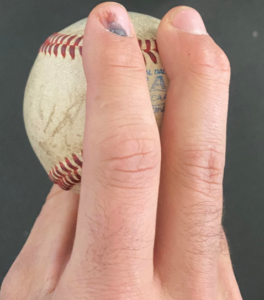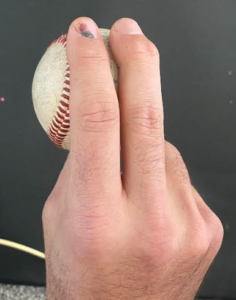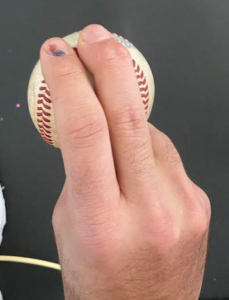Learning how to throw a good two-seam fastball can be a game-changer as a pitcher.
With a two-seamer, it’s a very similar process to throwing a regular four-seam fastball, so if you have one of those days when you’re struggling to throw strikes with offspeed pitches, your two-seam fastball can be a key secondary pitch that keeps hitters guessing.
As a former right-handed pitcher, I relied heavily on my two-seam fastball by throwing it inside to right-handed hitters and down and away to left-handed hitters.
Let’s dive into some key takeaways that I learned over the years and look at some of the all-time great 2 seam fastballs in baseball history.
Contents
Two-Seam Fastball Grip
There are several different ways pitchers grip their two seem fastballs, but all achieve the same result; two-seam rotation coming out of the hand toward home plate.
Here are some of the most popular options:
Across seams
A common two-seam grip is placing your index finger and middle fingers directly on the top seam with a slight separation between your fingers while using your thumb for balance on the opposite side of the ball along the curved seam.
Thumb placement for two seamers can vary from pitcher to pitcher with their two-seam fastball. Some pitchers prefer to use their thumb to help generate additional spin on the ball, while others rest their thumb on the back of the ball solely for balance purposes.
Experimenting with thumb placement in your bullpen sessions is best to determine what works best for your hand size and comfort level.
Along the Seams
Using your index finger and middle fingers along the seams is another popular two-seam fastball grip that allows pitchers to keep most of their fingers on the seams compared to the grip mentioned above, where it is mostly just the fingertips.
Having additional coverage on the seams with your entire fingers can help provide additional leverage on the ball to create arm-side movement.
Horshoe Seam
My favorite two-seam baseball grip was using the horseshoe seam because it felt very similar to the four-seam fastball grip in my hand. This grip required moving my middle and index finger over slightly to the right from my four-seam grip and gave my fastball some arm side run.
This pitch didn’t move as much as the grips mentioned above, but I felt like I had better control over the ball and could still throw it nearly as hard as my four-seam fastball.
Try different finger placements along the horseshoe to see if you get better movement with one location than the other. I liked to use the corner of the horseshoe so I could comfortably rest my thumb on the bottom seam.
The key takeaway with two-seam fastball grips is experimentation. No two pitchers are built the same so make sure you dedicate time to working on finding the perfect two-seam grip that works for you and your arm slot.
How to throw a two-seam fastball
Throwing a two-seam fastball should be very similar to throwing your four-seam fastball. The first priority when developing your two-seam fastball is to find the ideal two-seam grip as mentioned above.
The grip should provide arm-side movement on the ball based on the aerodynamic nature of the ball spinning toward the home plate.
Once you have found a grip that works, there are a few advanced two-seam tactics that can help generate even more movement on the ball:
Throwing the Inner Third of the Ball
If you were to divide the ball into three segments; the inner, middle, and outer third, one advanced tactic is to focus on letting the ball roll off of your fingers while trying to drive your hand through the inner third of the ball.
This will help generate even more natural arm-side movement than just relying on the grip alone.
Hand/Wrist Angle
Experimenting with the angle of your wrist is another way to help generate additional arm-side run on your 2-seam fastball.
When you throw a four-seam fastball, you are likely keeping your wrist at an upright angle pointed toward the sky so you can help generate as much spin as possible while trying to throw the ball straight.
A slight wrist tilt can help you generate some natural arm-side run since the ball will be coming out of your hand at an angle instead of directly straight down like your normal four-seamer.
This method takes a significant amount of practice since the timing of releasing the ball will be slightly more difficult than the normal angle you are releasing the ball at.
Throwing my two-seamer with a slight change in my wrist angle was my favorite way to throw it because it almost felt exactly like throwing my four-seam fastball out of my hand, except I was throwing it at a slightly different angle.
You may not get as much downward movement on the ball as you would with a typical heavy sinker, but you generate hard natural arm-side movement that you don’t have to think about.
Arm Slot
Experimenting with your arm slot is another way to help generate some natural movement. If you struggle with commanding your two-seamer and the above methods are too complex for your to master, making a slight adjustment in your arm slot can be an easy way to generate some arm side run on the ball.
If you have an over-the-top delivery style, try moving your hand 3-6 inches further away from your head while maintaining the exact same delivery. This should help create some diagonal spin on the ball that helps give the ball slight movement on it.
Other Two Seam Fastball Tips
Experiment with different grips
Two-Seam Fastball Movement
There are a few different ways a two-seam fastball typically moves.
Hard Lateral Movement
Major league pitchers are throwing their two-seam fastballs harder than ever, and the movement on these high-velocity two-seamers is much different than two-seam pitchers of old.
Instead of a 3-5 mph pitch slower than their four-seamer, it is being thrown a mile or two slower and has hard lateral movement on the ball.
This pitch can be thrown inside on right-handed hitters from a righty and as a comeback two-seamer against left-handed hitters.
A comeback two-seamer thrown by a Right-handed pitcher against a left-handed hitter or opposite is one of the hardest pitches to hit because it appears as if the pitch is being thrown directly at your hip! Joe Kelly is one of the best at comeback two seamers:
Hard downward lateral movement
The traditional sinker is still one of my favorite pitches in baseball, and Logan Webb from the Giants is one of the best in baseball currently. Big league pitchers spend time working on perfecting all of their pitches and Webb has one of the best in baseball.
Webb throws his sinker at around 94 mph and has great lateral and downward movement on the ball.
As a starting pitcher, if you can throw your fastball for strikes and miss barrels, you will have a long career!
Here is an awesome video of Webb breaking down how he grips and throws his two-seamer:
Late Movement (tailing fastball)
Another type of two-seam fastball is a tailing fastball that doesn’t move as much as the two options listed above but has late arm side movement, similar to how a cutter moves but in the opposite direction.
As seen in the video above, Yu Darvish has one of the best late-movement fastballs.
If you struggle to locate a traditional two-seamer throwing a tailing fastball is another option if you want variety from your four-seam fastball.
Ground Ball Rate
One pitching stat that is closely monitored by the analytics department is pitchers’ ground ball rate.
A high ground ball percentage means fewer balls are likely to leave the ballpark, and fielders have more chances to make plays.
A two-seam fastball is one of the best ways to increase ground ball rates.
Let’s take a look at some of the best ground ball percentages from starting pitchers in recent history:
|
Pitcher |
Year |
Ground Ball % |
|
Framber Valdez |
2022 |
66.5% |
|
Framber Valdez |
2021 |
70.3% |
|
Randy Dobnak |
2020 |
62.1% |
|
Dallas Keuchel |
2019 |
60.1% |
|
Marcus Stroman |
2018 |
62.1% |
|
Dallas Keuchel |
2017 |
66.8% |
|
Marcus Stroman |
2016 |
60.1% |
|
Brett Anderson |
2015 |
66.3% |
The one common trait among these pitchers above is that they all have great 2-seamers.
Four-Seam vs. Two-Seam Differences
Here are some of the main differences between the 2 seam fastball and the four-seam fastball:
Velocity
The four-seam fastball will typically be 2-3 mph faster than a four-seam fastball because only two seams are spinning in rotation toward home as compared to four with the fastball.
Additionally, the fastest way to point A to point b is in a straight line, so any lateral movement on the ball will slow it down, while the four-seamer is intended to be straight.
Movement
Two seamers move at various distances and angles depending on who is throwing the pitch.
One of the reasons that this pitch is one of my favorite pitches is that there are so many different methods of grips, hand placement, arm angles, and velocity from pitcher to pitcher.
Hitters reaction
Hitters that are prepared for a four-seam fastball can guess what is coming and get lucky on straight four-seam fastballs from time to time.
For instance, if a batter thinks there is a 0-0 low and away fastball coming, a straight pitch will be easier to “guess right” on than a moving one. A good two-seam fastball with good movement is taught to square the barrel up and is much harder for hitters to hit.
Difficulty
For most pitchers, the two-seam fastball is much more difficult to learn than the four-seam fastball.
From a young age, most baseball players are taught to grip the baseball across one of the four seams, which they have created for most comfort-level throwing.
If you want to master the two-seamer, the key is putting in the reps and throwing the baseball with the two-seam grip as much as possible. Throw it during warmups, flat ground bullpens, and other situations to create hand and muscle memory, and it will become second nature over time.
Seam rotation
Shohei Ohtani, Four Seam Fastball & Two Seamer, Overlay pic.twitter.com/uxIY5SjJdI
— Rob Friedman (@PitchingNinja) August 16, 2022
Two-seam fastballs are rotating with two seems at a time toward home plate instead of four seems.
If you have a baseball lying around your house, grip the ball by two seems, spin it into the air slowly, and do the same with the four-seam grip. You will see the rotations in slow motion and the difference in spin rotations firsthand.
3 Benefits of throwing two-seam Fastballs
1. Miss barrels
Sonny Gray, Painted 93mph Four Seam Fastball and Painted 92mph Two Seamer, Overlay pic.twitter.com/KEqyCmqK8p
— Rob Friedman (@PitchingNinja) August 23, 2022
One of the main reasons I enjoyed throwing my two-seamer was that I could throw it as hard as possible and have a greater likelihood of missing the sweet spot on the hitter’s bat. Straight pitches are easier to “barrel up”-or hit in the sweet spot.
If I wasn’t throwing a down-and-away fastball to a right-handed hitter that needed to be straight, I liked to throw a hard two seemer down in the zone to try and generate ground ball outs.
If you don’t have an overpowering four-seam fastball, a two-seamer is a great way to make it challenging for hitters.
2. Plays in any weather
I played college baseball in cold weather for most of the early part of the season, making it pretty challenging to get a good grip and command of my changeup or curveball.
When your fingers are cold, your touch and feel aren’t the same, so you may be left with only a fastball that you can comfortably locate on some days.
If you develop your two-seamer, it can serve as an additional variety pitch that you mix in there and keep hitters off balance on days you struggle with controlling your offspeed. Pitching is all about keeping hitters off balance, and mixing in a two-seam fastball is a great way to do so.
3. Generates Ground Balls
Since most two-seam fastballs have downward movement, they are more likely to generate ground ball outs from hitters.
If you have average to below-average fastball velocity, a flat four-seam fastball that doesn’t move is at risk of getting crushed if you don’t locate it correctly.
Many two-seam fastball pitchers like Derek Lowe and Brandon Webb had below-average velocity but had long Major League careers because they could locate their two-seamer and their other types of pitches.
Best MLB Two-Seam Fastballs
1. Greg Maddux
Maddux is one of the goats when it comes to location and two-seam fastballs, and the pitch is one of the reasons he maintained such a low ERA.
Maddux used his incredible control to paint the edges with his two-seam fastball and wasn’t afraid to throw it to both right and left-handed hitters.
2. Derek Lowe
Lowe didn’t have overpowering velocity but relied on his heavy sinker to generate tons of ground balls throughout his career.
Lowe was one of the most clutch pitchers of his era during stretches with the Red Sox and Dodgers.
3. Brandon Webb
Brandon Webb barely broke 90MPH but won the Cy Young in 2006 by relying on his nasty sinker.
Webb had one of the best sinkers of all time that was thrown and had an incredible ground ball to fly ball ratio of 1.82.
4. Bartolo Colon
Bartolo Colon is one of the most fascinating pitchers of all time and pitched 21 years in the Major Leagues until the age of 45 and recently pitched in the Mexican leagues at age 48!
Colon threw in the mid-90s earlier in his career, but as he lost velocity, he started to throw an upper 80s two-seam fastball that was a big part of his success later in his career.
5. Kyle Hendricks
Hendricks has been one of the best control pitchers in the modern era, and he relies on a nasty changeup and impressive two-seamer to keep hitters off balance.
Final Word
As you can see, the two-seam fastball is well worth your time to learn as a pitcher. Experiment with your finger placement and grip on the baseball to find out what works best for your hand and arm movement. No two pitchers are exactly the same, so exploration with this pitch is critical to find the perfect comfort zone in your release point.
Even if you have an overpowering fastball at a young age, as you move up in competition, advanced hitters will eventually catch up to your four-seam fastball, no matter how hard it is.
The earlier you start to work on your two-seamer, the more likely it will become second nature, and you will develop the confidence needed to throw it in games.




